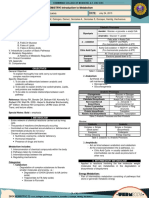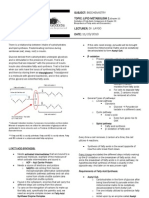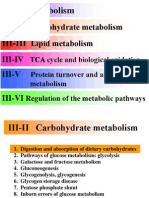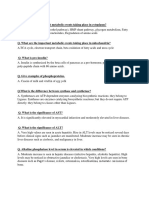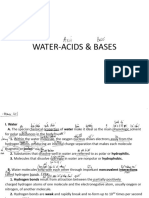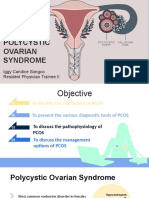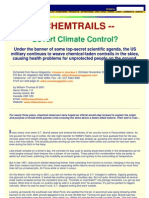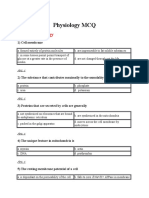Biochemistry 1.1 Introduction To Water and Buffers
Biochemistry 1.1 Introduction To Water and Buffers
Uploaded by
lovelots1234Copyright:
Available Formats
Biochemistry 1.1 Introduction To Water and Buffers
Biochemistry 1.1 Introduction To Water and Buffers
Uploaded by
lovelots1234Original Description:
Original Title
Copyright
Available Formats
Share this document
Did you find this document useful?
Is this content inappropriate?
Copyright:
Available Formats
Biochemistry 1.1 Introduction To Water and Buffers
Biochemistry 1.1 Introduction To Water and Buffers
Uploaded by
lovelots1234Copyright:
Available Formats
BIOCHEMISTRY
1.1. Introduction to Water, Acids, Bases, and Buffers
Dr. Alba
2018A
Alvarez, E.M. A., Alvarez, L., Alvero, G., Amadore, R., Amog, P., Ang, D.
Outline
WATER
A. Biochemistry of Water
B. Properties of Water
C. Water as Solvent
D. Water and Thermal Regulation
E. Total Body Water
II. OSMOLALITY
III. pH
A. Acid
B. Base
C. Henderson-Hasselbach Equation
IV. BUFFER
o
o
I.
Objectives
To be able to differentiate among individuals
its distribution and factors affecting it
To be able to apply the properties of water
and its uses in our daily life
To recognize the role of water and its
biochemical properties
To be able to determine acids, bases, and
buffers in everyday living
To be able to apply Hendeson-Hasselbach
equation
To familiarize with cases concerning water
balance and basic acid-base problems
I. WATER
Predominant chemical component of a living
organism
Forms an essential part of body cells and
fluids
Matrix of many living reactions
Universal solvent
Medium in intracellular and extracellular
processes
Transport system
Cushion
High surface tension
Liquid at room temperature
o High boiling point
o High freezing point
Alvarez|Alvarez|Alvero|Amadore|Amog|Ang
June 18, 2014
1st Semester, A.Y. 2014-2015
Temperature regulation
High latent heat of vaporization
A. Biochemistry of Water
Consists of 3 atoms: 2 hydrogen atoms and
1 oxygen atom
Dipolar:
o Allows it to form hydrogen which is
responsible for the solvent property
o Both with positive and negative ends
Has 2 unshared electrons that form an
electron dense cloud
Has strong tendency to form hydrogen
bonds
o Acts as hydrogen donor (acid) and acts
as
hydrogen
acceptor
(base)
simultaneously
Example: Its ionization may mean
an intermolecular proton transfer to form
hydronium ion (H3O+) and hydroxide
ion (OH-)
o Water is a reactant or product in many
metabolic processes
Bent molecule with a bond angle of 105
Figure 1. Water Molecule
Type of covalent bond is called a polar bond
o Due to the separation of charge
Partial negative on the oxygen is twice the
strength of a hydrogen since it shares
electrons with 2 hydrogen atoms.
Both the hydrogen and oxygen atoms form
hydrogen bonds and participate in the
hydration shell
Oxygen binds with 2 hydrogen atoms so each
water molecule is hydrogen bonded to 4 close
water molecule in fluid
Page 1 of
molecules: stay in hydration shell for 2.4
nanoseconds
D. Water and Thermal Regulation
Figure 2. Hydrogen Bonding
Hydrogen Bond
o Enable water to dissolve many organic
biomolecules with functional groups which
can participate in binding
1. Oxygen atoms of aldehydes
2. Ketones
3. Amides
4. Alcohol and Amines
B. Properties of Water
1. Cohesion
- attraction between particles of same
substance
surface tension
- strength of waters surface
- enables insects to walk on water
2. Adhesion
- attraction between two different
substances
3. High conductivity
4. High latent heat of vaporization
C. Water as Solvent
Dissolution: water forms bonds and
electrostatic interactions
Hydrogen bonds: strong enough to dissolve
polar molecules in water and to separate
charges; weak enough to allow movement of
water and solutes
H-bond between two water molecules: 4kcal
(1/20th of strength of covalent bond)
Waters strong dipole and high dielectric
constant enable water to dissolve large
quantities of charged compounds
Average H-bond between water molecules:
lasts only 10 picoseconds; each water
Alvarez|Alvarez|Alvero|Amadore|Amog|Ang
Structure of water: allows it to resist
temperature change
High heat of fusion = large dropp of
temperature as needed to convert liquid water
to solid state of ice
High thermal conductivity = facilitates
dissipation of heat
High heat capacity and heat of vaporization
E. Total Body Water
Total amount of body water: CONSTANT
Tissue concentration: VARIES
Average lean adult male:
60% fluids, 40% solids
Average lean adult female:
55% fluids, 45% solids
Table 1. Amount of Total Body Water Among
Sexes, Period of Development and Based on
Weight
Infant
Male Adult
Female Adult
Thin
80
65
60
Average
70
60
55
Obese
65
55
45
Factors affecting amount of body water:
Body weight - heavier you are the less total
body water
Age - older you are the less total body water
Sex - men are leaner, therefore have more
total body water than females
Amount of fat - fatter you are the less total
body water
Page 2 of
Computations for total body water and amount of
water in different body compartments:
Total body water = 0.6 x body weight
Extracellular fluid (ECF)= 0.2 x body weight
o Interstitial fluid = 0.75 x ECF
o Plasma fluid = 0.25 x ECF
Intercellular fluid (ICF) = 0.4 x body weight
Facts on water and its distribution
Half-life of water: 9.3 days
Fluctuation: less than 1% of body weight
per day
Intake and output: 2000mL at normal
conditions
Affected by:
o Climate
o Activity
o Diet
o State of health
Table 2. Typical Daily Water Balance (average
build, normal, adult, male)
Water Intake
Drinking Water
600
Water in other beverages
400
Performed Water
700
Metabolic Water
300
Total
2000
Water Output
Skin
500
Lungs
400
Urine
1000
Stool
100
Total
2000
II. OSMOLALITY
Water is distributed dependent on the
concentration of solutes in the body
It is proportional to total concentration of all
dissolved molecules
Osmotic force attraction of particles in a
solution
o Dependent on number of particles or ions
in a solution
o Water flows from region of low osmotic
pressure to a region of high osmotic
pressure
Alvarez|Alvarez|Alvero|Amadore|Amog|Ang
Osmolality - measure of osmotic pressure,
total concentration of dissolved particles in a
solution
Unit of osmotic pressure: osmole (OSM)
= 10milliosmole per kg solvent
Equation of total osmolality:
[
where:
2[Na] = [Na] x [Cl]
GLU = glucose (FBS fasting blood sugar;
FBG fasting blood glucose)
BUN = urea; blood urea nitrogen
Osmolality is regulated by changing the total
body water and not by changing body solute
Measurement of osmolality (water balance) in
one compartment will reflect osmolality in all
compartments
Serum sodium concentration - measure of
body osmolality; used to diagnose disorders of
water balance
Fluid Compartments: (Chief osmotic particles)
Extracellular: Na, HCO3, Cl
Intracellular: K, Mg, PO4
Table 3. Distribution of Cations and Anions
Between ECF & ICF
In
ECF
ICF
mEq/L
Na
145
12
K
4
150
Ca
5
0.001
Cl
105
5
HCO3
25
12
P
2
100
pH
7.4
7.1
Control state:
Hypertonic NaCl intracellular K will move out
to extracellular fluid; crenate
Water extracellular Na will move in to the
intracellular fluid; lyse
Isotonic saline equal movement; controlled
state
Page 3 of
III. pH
Dissociation of water
Forms H+ and OH- and extent is 0.0000001 M
or 10-7 mol/l the concentration of hydrogen
ions in a solution
It is the negative log of hydrogen ion
expressed in moles/liter (mol/L)
Expresses the relationship between H ion
concentration and the hydroxide ion
concentration and the concentration of water at
equilibrium
Sorensen first introduced the term pH in
1909
pH of pure water = 7
pH 7.0 neutral pH; H and OH are equal
Higher pH = low concentrations of H
Dissociation constant of water (Kd or Keq)
Expresses the relationship between H ion
concentration and the hydroxide ion
concentration and the concentration of water at
equilibrium
Because water dissociates to small extent, it is
constant at 55.5M: multiplication of Kd of water
by 55.5 gives the ion product of water (Kw)
=([+][]) / [2]
=(+)()=11014
* Water Molecules exhibit a slight tendency to
dissociate.
Act both as acid and base -> its ionization
may mean an intermolecular proton transfer to
form hydronium ion (H3O) and hydroxide ion
A. Acid
Higher H ion concentration and lower OH ion
concentration than pure water
Donate a hydrogen ion to a solution
Bronsted Lowry
o Proton or H donor in a reaction
o Usually tastes sour
o Turns blue litmus paper to red
Lewis
o Potential electron pair acceptor in a
reaction to form a covalent bond
Arrhenius
o Compounds that dissociates in water to
form H+
Strong and Weak acids
Alvarez|Alvarez|Alvero|Amadore|Amog|Ang
During metabolism, several acids increases
H in the body thus decreases the pH
o Weak or strong dependent on the degree
of dissociation
o A strong acid is the one that completely
dissociates or 100% ionizes in water
solution
Metabolic acids: metabolized at the level of
the liver and lungs
Non-metabolic acids: excreted by the
kidneys
Equilibrium constant for the dissociation of a
weak acid:
The tendency of an acid to dissociate and donate
a hydrogen ion to a solution is a Ka
()+()+()
=([+][]) / []
=log10
Acids produced by the Body:
o Volatile acids
CO2
o from decarboxylations in citric acid cycle
o 13,000-20,000 mmol/day
o Eliminated through the lungs
CO2 + H2O = H2CO3 = H+ + HCO3carbonic anhydrase
o
Non-volatile acids (Non-carbonic/Fixed
acids)
50-80 mol/day
Organic (such as lactic acid and ketone
bodies) or inorganic
Due to catabolism of food:
1. Diet:
a) Sulfuric acid H2SO4 (contains
methionine, cysteine and cystine)
from sulfur-containing amino acids
b) Phosphoric acid (H3PO4) from
phosphoproteins/phospholipids
c) Uric acid from purine metabolism
2. Intermediary metabolism:
a) Lactic acid from carbohydrates
when O2 is low
b) Ketoacids from fats (acetoacetic
(acetone) and Beta-hydroxybutyric
acid when DM is uncontrolled)
3. Bicarbonate losses in the stool:
a) Diarrhea addition of non-volatile
acids
B. Base
Page 4 of
Basic solutions have a higher OH ion
concentration and lower H ion concentration
than pure water
Bronsted Lowry
o Proton or H acceptor in a reaction
o Turns bitter and feels slipper or soapy
o Turns red litmus paper to blue
Lewis
o Potential electron pair donor in a
reaction to form a covalent bond
Arrhenius
o Compounds that dissociates in water to
form OH (hydroxide)
Strong and Weak bases
o A strong base is the one that completely
dissociates
C. Henderson-Hasselbach Equation
Equation relating the pH to the composition of
the buffer solutions
IV. BUFFER
Consists of a weak acid and it conjugate base
or a weak base and it conjugate acid
Resists changes in pH
Buffer Capacity
o Equivalents of (H) or (OH) required to
change 1L of buffer by 1.0 pH unit
o Measure as the effectivity of a solution to
resist pH changes
o Maximum buffer capacity occurs at +/- 1
pH unit on either side of the pKa
Acid-Base Buffer Systems:
Conjugate acid-base pairs that bind or release
H+ when an acid or base is added to he body
so that the change in pH is minimized
1st line immediate defense against pH changes
Bicarbonate-carbonic acid: major buffer
system of the body
Alvarez|Alvarez|Alvero|Amadore|Amog|Ang
A. Blood pH
7.36 and 7.44 (7.35 to 7.45)
Intracellular pH at 7.1
Extracellular pH must be maintained to allow
metabolic functions of the liver, beating of the
heart, and conduction of neural impulses is
6.8-7.8
B. Buffers in the Body
1. Bicarbonate Buffer System (ECF)
Major source of metabolic acid in the
body: CO2 (produced principally from fuel
oxidation from the TCA or tricarbocylic
acid cycle)
Normal: 13 mol of CO2/day
Regulation of CO2 availability by
respiration
Increased HCO3, increased pH alkaline
Increased pCO2, decreased pH acidic
2. Hemoglobin Buffer System (RBC)
Bicarbonate buffer system +
haemoglobin: buffering the blood,
transporting CO2 in the lungs
3. Phosphate Buffer (ICF)
Non-volatile acids that is produced from
body metabolism cannot be excreted as
CO2 is excreted in the urine (usually from
sulfuric acids, phosphates, and ammonia)
C. Acid-Base Balance
---------------
Regulated by:
1. Liver
o Metabolizes proteins that produces
hydrogen ions
2. Lungs
o Removal or retention of CO2
Net gain of CO2: Hypoventilation
Net loss of CO2: Hyperventlation
o Excess CO2 combine with water to
form carbonic acid (H2CO3)
3. Kidneys
o Generate new HCO3
o Regulate plasma bicarbonate by
reabsorbing filtered bicarbonate
Page 5 of
It affects hydrogen ion excretion thru
the formation of titrable acids and
ammonium (synthsis)
Excrete acid in the form of dihydrogen
phosphate (H2PO4), bicarbonate
(HCO3), ammonia (NH3)
D. Acid-Base Disorders
Change in Extracellular pH
o conditions that initially affect either HCO3(base) or pCO2 (acid-carbonic acid)
leading to a shift in pH from normal;
(homeostasis is lost)
o May be caused by:
Renal or respiratory function is
abnormal
Acid or base overload overwhelms the
capacity to excrete
Changes in plasma H concentration and pH
can be induced by alterations of pCO2 and
plasma bicarbonate (HCO3-) concentration
pCO2: regulated by respiration -> primary
disturbance: respiratory acidosis/alkalosis
primary
disturbance
in
bicarbonate
concentration(HCO3-)
:metabolic
acidosis/alkalosis
Evokes a compensatory response that is the
same direction as the primary disturbance
Arterial Blood Gases (ABGs)
pH=7.35-7.45
pCO2=35-45 mmHg
HCO3=21-28 mmHg
pO2=80-100 mmHg
Anion gap
Means
of
approximating
the
total
concentrations of anions other than Cl- and
HCO3- in the plasma
Sum of the major cations in the plasma minus
the sum of the major anions
=([Na+] + [K+]) ([Cl-] + [HCO3-]
=12mEq/L
1. Metabolic acidosis fall in the plasma
bicarbonate and a low pH (pH<7.35)
Compensatory response:
a. Increase in ventilation
b. Renal excretion of excess acid (takes
several days) total restoration
Caused by:
o Loss of alkali (diarrhea, GIT fistulas and
drainages)
o Accumulation of fixed acids (increase in
lactic acid due to shock/hypoxemia,
uncontrolled diabetes mellitus, renal
failure)
2. Metabolic alkalosis elevation of plasma
bicarbonate and a high pH (pH>7.45)
Caused by:
o Bicarbonate administration loss of acid
(relative increase in alkali): hydrogen loss
like vomiting, use of diuretics, ingestion of
alkali compounds (Maalox)
3. Respiratory acidosis increase in pCO2
(pH<7.35); decrease effective alveolar ventilation;
increased CO2 leads to decreased pH (or increase
in production of carbonic acid)
Caused by:
o neuromuscular trouble, depression of
airway regulation, lung disease or airway
obstruction
At risk: abnormal surgery px, analgesia
4. Respiratory alkalosis decreased in pCO2
(pH>7.45)
Caused by:
o hyperventilation (CNS disorders,
medication), conditions that increases the
excretion of carbon dioxide,
hypermetabolic states (overstimulation of
the respiratory center)
*Recommended video:
https://www.youtube.com/watch?v=eK2dBdBRvCU
ACIDOSIS: pH less than 7.35
ALKALOSIS: pH more than 7.45
GUIDE QUESTIONS
Alvarez|Alvarez|Alvero|Amadore|Amog|Ang
Page 6 of
Who among the follow has the highest total body
water?
a. average male- 60% fluids
b. obese women- fatter you are the lower the
total body fluids
c. thin infant- younger therefore has
highest total body water compared to
other options
d. thin male- has high total body water but is
older so less body water compared to thin
infant
Which of the following statements about water id
true?
a. It is the universal solute
b. It forms a minor part of all body cells and
fluids
c. The total amount of body water varies
d. Water has a high latent heat of
vaporization
SOURCES
Devlin, T. (2011). Textbook of Biochemistry with
Clinical Correlations, Wiley-Liss 7th edition.
New York: A John Wiley & Sons, Inc.,
Publication
Murray, R.K., et al., (2009) Harpers Illustrated
Biochemistry, 28th ed, Prentice Hall
International
Oxford Dictionary of Biochemistry and Molecular
Biology, OKxford University Press Inc., New
York
Alvarez|Alvarez|Alvero|Amadore|Amog|Ang
Page 7 of
You might also like
- POGS CPG Abnormal Uterine BleedineDocument36 pagesPOGS CPG Abnormal Uterine Bleedinejandale57% (7)
- Legal Medicine Review Questions WITH KEY ANSWERDocument6 pagesLegal Medicine Review Questions WITH KEY ANSWERlovelots123494% (31)
- CPG-3rd Trimester Bleeding and Postpartum Hemorrage 2009Document107 pagesCPG-3rd Trimester Bleeding and Postpartum Hemorrage 2009lovelots1234100% (9)
- CPG-Abnormal Labor and Delivery 2009Document29 pagesCPG-Abnormal Labor and Delivery 2009lovelots123488% (8)
- 2.1 (BIOCHEMISTRY) Introduction To MetabolismDocument6 pages2.1 (BIOCHEMISTRY) Introduction To Metabolismlovelots1234100% (1)
- Anatomy 1.4 Upper Limbs - Muscle and FasciaDocument10 pagesAnatomy 1.4 Upper Limbs - Muscle and Fascialovelots1234No ratings yet
- Chapter 1 Summary For BiochemistryDocument16 pagesChapter 1 Summary For BiochemistryKyle BroflovskiNo ratings yet
- Valvular Heart Disease Medical Surgical NursingDocument75 pagesValvular Heart Disease Medical Surgical NursingGodfrey Franco88% (8)
- Korean Hand AcupunctureDocument81 pagesKorean Hand AcupunctureKarl100% (4)
- Uric Acid MetabolismDocument3 pagesUric Acid MetabolismAlifah SyarafinaNo ratings yet
- Biochemistry 1.4 Enzymes Classification and KineticsDocument11 pagesBiochemistry 1.4 Enzymes Classification and Kineticslovelots1234100% (1)
- Lec Notes Carbohydrate Metabolism Glycolysis Kreb Cycle ETCDocument12 pagesLec Notes Carbohydrate Metabolism Glycolysis Kreb Cycle ETCJonah Micah MangacoNo ratings yet
- Intro To Metabo (IsmDocument8 pagesIntro To Metabo (IsmManila MedNo ratings yet
- Carbohydrate ChemistryDocument2 pagesCarbohydrate ChemistryLakshmi VenkataramanNo ratings yet
- ImmonoDocument13 pagesImmonoManila MedNo ratings yet
- Concept of PH and BufferDocument27 pagesConcept of PH and BufferRolling Coast100% (1)
- Overview of Metabolism & The Provision of Metabolic Fuels (CHP 16 Harper) - TJLDocument6 pagesOverview of Metabolism & The Provision of Metabolic Fuels (CHP 16 Harper) - TJLM100% (1)
- Biochemistry CurriculumDocument6 pagesBiochemistry CurriculumcelecosibNo ratings yet
- Chapter 20 Electron Transport and Oxidative PhosphorylationDocument14 pagesChapter 20 Electron Transport and Oxidative PhosphorylationRaabia Ansari100% (1)
- Buffers Notes1Document3 pagesBuffers Notes1Lara MonevaNo ratings yet
- Lec Notes - Buffers, Acidosis, and Alkalosis PDFDocument3 pagesLec Notes - Buffers, Acidosis, and Alkalosis PDFJonah Micah MangacoNo ratings yet
- Carbohydrate Chemistry: Digestion, Absorption & TransportDocument14 pagesCarbohydrate Chemistry: Digestion, Absorption & TransportManila MedNo ratings yet
- Lipids: Fatty AcidsDocument10 pagesLipids: Fatty AcidsRhealyn IliganNo ratings yet
- Isolation and Characterization of Saponifiable and NonDocument18 pagesIsolation and Characterization of Saponifiable and NonJhoanna Rein Duzon100% (2)
- Buffer 0Document27 pagesBuffer 0Adinda Nur AdilaNo ratings yet
- BIOCHEM-Lipid Metabolism 1Document12 pagesBIOCHEM-Lipid Metabolism 1Std Dlshsi100% (2)
- BIOCHEM - 2S05 - Nucleotide MetabolismDocument10 pagesBIOCHEM - 2S05 - Nucleotide MetabolismRonak UpadhyayNo ratings yet
- 2.6 (BIOCHEMISTRY) Glycogen MetabolismDocument10 pages2.6 (BIOCHEMISTRY) Glycogen Metabolismlovelots1234100% (1)
- General Protein MetabolismDocument72 pagesGeneral Protein MetabolismHafizie Syahman100% (2)
- 2.1 Molecules To Metabolism-STUDENTDocument54 pages2.1 Molecules To Metabolism-STUDENTAngel Alexandra SiregarNo ratings yet
- BufferDocument5 pagesBufferAnisulHaqueNo ratings yet
- General and Specific Tests For CarbohydratesDocument14 pagesGeneral and Specific Tests For CarbohydratesarellanokristelleNo ratings yet
- LIPIDS D PharmDocument65 pagesLIPIDS D PharmMadhuri poulkarNo ratings yet
- Integration of Metabolism Integration of MetabolismDocument10 pagesIntegration of Metabolism Integration of MetabolismEdison Luciano100% (1)
- Lipid Chemistry: BiochemistryDocument14 pagesLipid Chemistry: BiochemistryManila Med0% (1)
- Biochemistry MIDTERMS LABDocument1 pageBiochemistry MIDTERMS LABcha cuteNo ratings yet
- Hexose Monophosphate ShuntDocument18 pagesHexose Monophosphate ShuntAbdul Jabbar Abdul JabbarNo ratings yet
- Carbohydrates Slide-2 PHARM-D, SALUDocument85 pagesCarbohydrates Slide-2 PHARM-D, SALUShahid AhmedNo ratings yet
- Gluconeogenesis: BiochemistryDocument10 pagesGluconeogenesis: BiochemistryManila Med100% (1)
- Nucleic Acids: PurinesDocument9 pagesNucleic Acids: PurinesRoahit RajanNo ratings yet
- Amino AcidsDocument52 pagesAmino AcidsDrbee10No ratings yet
- Carbohydrates 131204014552 Phpapp02 PDFDocument27 pagesCarbohydrates 131204014552 Phpapp02 PDFTweenie Dalumpines100% (6)
- Isolation and Characterization of Complex Lipids From Chicken BrainDocument8 pagesIsolation and Characterization of Complex Lipids From Chicken BrainMaria Christina PaineNo ratings yet
- Amino Acids and ProteinDocument36 pagesAmino Acids and ProteinAmar DhereNo ratings yet
- Fatty Acid Synthesis: Prepared By: Divine Mary C. Mamalayan Iii-A BSBTDocument56 pagesFatty Acid Synthesis: Prepared By: Divine Mary C. Mamalayan Iii-A BSBTVanillae Dela Cruz100% (1)
- 2.2 (BIOCHEMISTRY) Carbohydrate Chemistry and MetabolismDocument8 pages2.2 (BIOCHEMISTRY) Carbohydrate Chemistry and Metabolismlovelots1234No ratings yet
- Carbohydrate Metabolism Lipid Metabolism Iii-IvDocument124 pagesCarbohydrate Metabolism Lipid Metabolism Iii-Ivomarou18100% (1)
- Carbohydrates: Introductory ArticleDocument12 pagesCarbohydrates: Introductory ArticleMauricio VidalNo ratings yet
- BIOCHEMISTRYDocument17 pagesBIOCHEMISTRYEthel May Granil100% (1)
- Modulator: Dr. P.B.Desai HOD, Dept of Biochemistry. Presenter: DR Vijayetha S. KagwadDocument68 pagesModulator: Dr. P.B.Desai HOD, Dept of Biochemistry. Presenter: DR Vijayetha S. KagwadvijayethaNo ratings yet
- (NOTES) Carbohydrates MetabolismDocument13 pages(NOTES) Carbohydrates MetabolismGabrielle Serrano100% (1)
- Experiment On TABADocument15 pagesExperiment On TABAHanaNo ratings yet
- Chapter 27 BioenergeticsDocument44 pagesChapter 27 BioenergeticsELAINE MARIEJOY MANGAOILNo ratings yet
- General and Specific Tests For CarbohydratesDocument11 pagesGeneral and Specific Tests For CarbohydratesBrian Rubiano0% (1)
- Chem 40.1 - Midterms Reviewer Discussion: Buffers: - (Aq) 2 4 - (Aq) 4 2 - (Aq) 2Document5 pagesChem 40.1 - Midterms Reviewer Discussion: Buffers: - (Aq) 2 4 - (Aq) 4 2 - (Aq) 2Steffi GatdulaNo ratings yet
- Digestion and Absorption of Dietary LipidsDocument35 pagesDigestion and Absorption of Dietary LipidsCharmaine Luc100% (2)
- Amino SugarsDocument2 pagesAmino SugarsNarasimha MurthyNo ratings yet
- Titration of Amino AcidsDocument21 pagesTitration of Amino AcidsCeleste Schepers0% (1)
- Biochemistry VivaDocument8 pagesBiochemistry VivaNazia WasimNo ratings yet
- Bioenergetics How The Body Converts Food To EnergyDocument38 pagesBioenergetics How The Body Converts Food To EnergyShereen Alobinay100% (1)
- Subject: Biochemistry Topic:Lipid Metabolism 2 Lecturer: Dr. Laygo DATE: NOV. 2010Document11 pagesSubject: Biochemistry Topic:Lipid Metabolism 2 Lecturer: Dr. Laygo DATE: NOV. 2010Std DlshsiNo ratings yet
- Electron Transport ChainDocument22 pagesElectron Transport Chainbluegreenalga100% (2)
- 2.5 (BIOCHEMISTRY) Electron Transport Chain and Oxidative PhosphorylationDocument7 pages2.5 (BIOCHEMISTRY) Electron Transport Chain and Oxidative Phosphorylationlovelots1234100% (2)
- Biophysical Chemistry Lecture 1 CHE 212Document55 pagesBiophysical Chemistry Lecture 1 CHE 212Solomon MbeweNo ratings yet
- Lec 4Document32 pagesLec 4bosco kiuriaNo ratings yet
- 1-1 Lecture, AdditionDocument10 pages1-1 Lecture, AdditionAnonymous guyNo ratings yet
- 1.1 Water & PHDocument105 pages1.1 Water & PHfardeensattar785No ratings yet
- Lesson1 - Presentation-Water & Acid-BaseDocument26 pagesLesson1 - Presentation-Water & Acid-BasengtanphuoclocNo ratings yet
- Lecture 2 - WaterDocument27 pagesLecture 2 - Waterapi-249972919No ratings yet
- Prenatal Care, Maternal Nutrition, IDADocument91 pagesPrenatal Care, Maternal Nutrition, IDAlovelots1234No ratings yet
- Polycystic Ovarian Syndrome: Iggy Candice Songco Resident Physician Trainee IIDocument78 pagesPolycystic Ovarian Syndrome: Iggy Candice Songco Resident Physician Trainee IIlovelots1234No ratings yet
- Maternal AnatomyDocument68 pagesMaternal Anatomylovelots1234No ratings yet
- CPG For Antibiotic Prophylaxis in Surgical ProceduresDocument27 pagesCPG For Antibiotic Prophylaxis in Surgical Procedureslovelots1234No ratings yet
- 2.6 (BIOCHEMISTRY) Glycogen MetabolismDocument10 pages2.6 (BIOCHEMISTRY) Glycogen Metabolismlovelots1234100% (1)
- Ebcpg Antibiotic ProphylaxisDocument31 pagesEbcpg Antibiotic Prophylaxispot_domingoNo ratings yet
- Upper Extremities Blood SupplyDocument35 pagesUpper Extremities Blood Supplylovelots1234No ratings yet
- Upper Extremities Nerve SupplyDocument19 pagesUpper Extremities Nerve Supplylovelots1234No ratings yet
- 2.4 (Biochemistry) Tca HMP and Uronic Acid PathwayDocument15 pages2.4 (Biochemistry) Tca HMP and Uronic Acid Pathwaylovelots1234100% (2)
- 2.7 (BIOCHEMISTRY) Gluconeogenesis - Better PicturesDocument12 pages2.7 (BIOCHEMISTRY) Gluconeogenesis - Better Pictureslovelots1234No ratings yet
- 2.2 (BIOCHEMISTRY) Carbohydrate Chemistry and MetabolismDocument8 pages2.2 (BIOCHEMISTRY) Carbohydrate Chemistry and Metabolismlovelots1234No ratings yet
- 2.5 (BIOCHEMISTRY) Electron Transport Chain and Oxidative PhosphorylationDocument7 pages2.5 (BIOCHEMISTRY) Electron Transport Chain and Oxidative Phosphorylationlovelots1234100% (2)
- Biochem 1.5 Bioenergetics PDFDocument7 pagesBiochem 1.5 Bioenergetics PDFlovelots1234100% (1)
- Anatomy 1.1 Anatomy in MotionDocument5 pagesAnatomy 1.1 Anatomy in Motionlovelots1234100% (2)
- Biochemistry 1.3 NeurotransmittersDocument10 pagesBiochemistry 1.3 Neurotransmitterslovelots1234No ratings yet
- Anatomy 1.2 Anatomy in MotionDocument4 pagesAnatomy 1.2 Anatomy in Motionlovelots1234No ratings yet
- Anatomy 1.1 - Anatomicomedical TerminologyDocument2 pagesAnatomy 1.1 - Anatomicomedical Terminologylovelots1234No ratings yet
- Prepositions SssDocument8 pagesPrepositions SssJoy KakodkarNo ratings yet
- Emergency MedicineDocument11 pagesEmergency MedicineJai Singh100% (1)
- Article 201 - Chronic Kidney Disease & Obesity-FelineDocument4 pagesArticle 201 - Chronic Kidney Disease & Obesity-FelineexcelhanammNo ratings yet
- Siddha2009 PDFDocument8 pagesSiddha2009 PDFdrjperumalNo ratings yet
- Adama KanuDocument41 pagesAdama KanuAlie TholleyNo ratings yet
- Comprehension Questions - Short Answer 4Document1 pageComprehension Questions - Short Answer 4SARASVATHY A/P KRISHNA MOORTHI MoeNo ratings yet
- Patterson, Sammon, Garg - 2016 - Dengue, Zika and Chikungunya Emerging Arboviruses in The New WorldDocument9 pagesPatterson, Sammon, Garg - 2016 - Dengue, Zika and Chikungunya Emerging Arboviruses in The New WorldLaise Eduarda Paixão de MoraesNo ratings yet
- Schizophrenia Spectrum and Other Psychotic DisordersDocument54 pagesSchizophrenia Spectrum and Other Psychotic DisordersJR BetonioNo ratings yet
- FLAVIVIRUSES Fbetl PDFDocument80 pagesFLAVIVIRUSES Fbetl PDFJustin TayabanNo ratings yet
- Hospital & Clinical PharmacyDocument14 pagesHospital & Clinical PharmacymahanteshNo ratings yet
- Chem Trails Climate ControlDocument7 pagesChem Trails Climate ControlThorsteinn ThorsteinssonNo ratings yet
- Psychiatric Presentation of Brain Infl Ammation: Bruno BrochetDocument8 pagesPsychiatric Presentation of Brain Infl Ammation: Bruno BrochetArhip CojocNo ratings yet
- HealthDocument17 pagesHealthRosevick BadocoNo ratings yet
- Disease of The Seventh DayDocument23 pagesDisease of The Seventh Dayapi-3743483No ratings yet
- Pembahasan TO 3 Agustus 15 PDFDocument802 pagesPembahasan TO 3 Agustus 15 PDFFahmi Afif AlbonehNo ratings yet
- D. C. Allen - John Donnes Knowledge of Renaissance Medicine - 1943Document22 pagesD. C. Allen - John Donnes Knowledge of Renaissance Medicine - 1943Myriam AitNo ratings yet
- 10 Medical Surgical Nursing Intensive Review PDFDocument68 pages10 Medical Surgical Nursing Intensive Review PDFShanine Alexia CordovezNo ratings yet
- 8 - Comments of Dra. EscarealDocument9 pages8 - Comments of Dra. EscarealBplo CaloocanNo ratings yet
- Penyakit MeniereDocument25 pagesPenyakit MeniereMuhammad Budiman Irpan BachtiarNo ratings yet
- Physiology MCQDocument32 pagesPhysiology MCQdip171100% (4)
- Disorders of AortaDocument25 pagesDisorders of Aortavani reddyNo ratings yet
- 03 Unicellular EukaryotesDocument14 pages03 Unicellular EukaryotesALYSSA BEYONCE FERMINNo ratings yet
- Abnormal Psychology DisordersDocument34 pagesAbnormal Psychology DisordersannaNo ratings yet
- Pathophysiology HypertensionDocument4 pagesPathophysiology HypertensionKimberly BautistaNo ratings yet
- Reliance Health Insurance Pre Authorisation FormDocument4 pagesReliance Health Insurance Pre Authorisation FormM/s MicrotechNo ratings yet
- Control de PacientesDocument54 pagesControl de PacientesKarina IzaNo ratings yet
- Post Partum AssessmentDocument28 pagesPost Partum AssessmentFlorence Peter100% (2)




